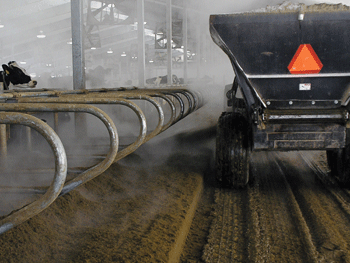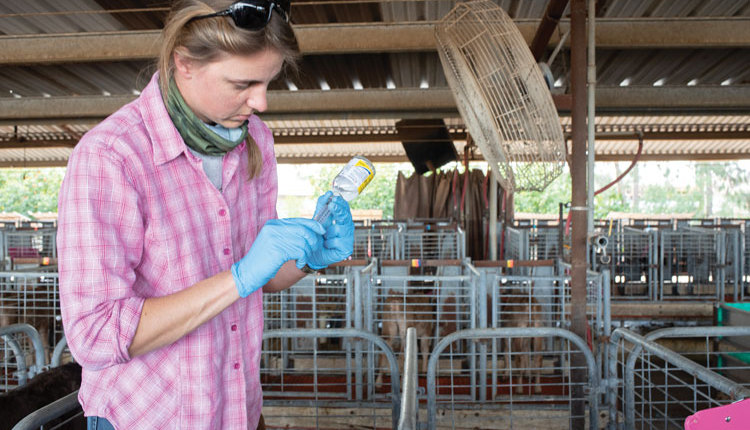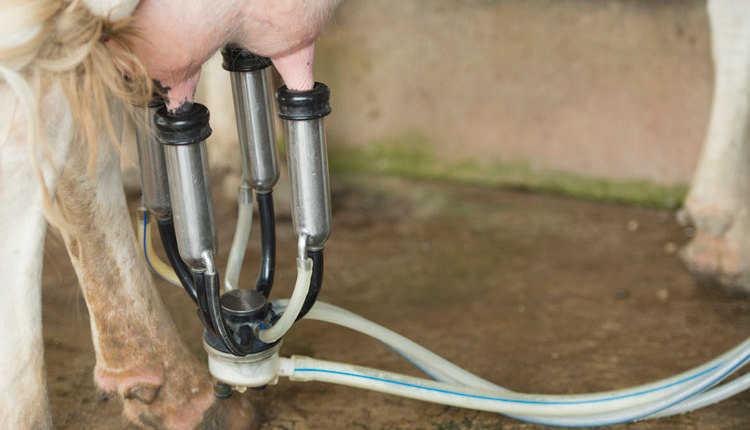The authors are with the Cornell Waste Management Institute at Cornell University. The authors would like to thank the Applied Economics and Management Department at Cornell University for running the economic analysis for the project.

Dried manure solids (DMS) can be an economical bedding source, but managing it well is key.
Scarcity of bedding has pushed farms to explore different bedding strategies. Use of dried manure solids (DMS) as bedding has been implemented by farms in the Northeast and other areas of the country. Farms are implementing this practice for economic and availability reasons but are finding, in addition, that it enhances cow comfort. A number of issues are of concern to these farms, including herd health and somatic cell count.
In a study funded by the New York State Energy Research and Development Authority (NYSERDA) and New York Farm Viability Institute (NYFVI), Cornell Waste Management Institute (CWMI) conducted research to study six Northeast U.S. farms using different DMS bedding strategies. One farm had side-by-side pens using sand, DMS that was drum composted, and DMS directly from the separator. Of the other five, two used DMS directly from the separator, one drum composted, one windrow composted, and one digested the manure before separation.
The farms were visited and evaluated over a one-year period from March 2006 through April 2007. At each visit, samples of used and unused bedding were taken for bacterial analysis on a volume basis, the farm owner/herdsperson was interviewed, and DairyComp 305 files were downloaded to gather somatic cell count (SCC) and mastitis information. Teat swabs were taken at the farm that used sand and DMS three times over the study period. We also performed teat end scoring at all farms to determine if it may have accounted for any differences in clinical mastitis.
Records going back to the year 2000 from Dairy Herd Improvement (DHI) were analyzed for the six study farms, as well as 65 New York State dairy farms that have a current herd size approximately the same as the study farms to assess the impact of continuing use of DMS on linear score (LS).
Does it start clean?
Bacterial levels in the sand, composted DMS, and solids that were digested started out, in unused bedding, with lower bacterial levels than the DMS directly from the separator. However, Escherichia coli and Klebsiella levels averaged less than 150 cfu/ml over the course of the study in unused bedding for all systems, and, once the bedding was in the stall, bacterial levels between the systems evened out. In fact, the strategies that started out with "clean" bedding tended to have significantly higher levels of bacteria in used bedding, indicating the bedding may have started out too clean (no competition from other bacteria). Also, bacterial levels in the used bedding at the farm using sand, composted DMS and DMS from the separator in side-by-side pens did not differ, indicating that it is more likely the bacterial levels in used bedding are a result of bacteria in the manure of the cow and how well stalls are cleaned, or the fecal matter tracked in from the alley, rather than how "clean" the bedding is when it is put in the stall.
There were significant differences in the physical properties of the unused DMS between the different systems. These differences indicate that it is the type and efficiency of the separator being used on the farm that helps determine the properties of unused DMS bedding.
Next, we analyzed our data to learn if the cleanliness of the unused bedding has an effect on the bacterial population of the used bedding. What is the link between the bacteria in unused and used bedding? One would expect that, if the bacterial content of the unused bedding determined the levels in the used, it would be the same bacteria (more E. coli in the unused would produce more E. coli in the used). We didn't see that. In some cases, increasing levels of one bacteria in unused bedding decreased levels of either that or a different bacteria in the used bedding, and the other way around.
Comparison of the bacterial population on the teat ends of cows bedded on DMS from the separator and cows bedded on sand at the same farm showed that the levels of Klebsiella, and gram negative and positive bacteria were higher on the teat ends of cows bedded on the DMS. It was not clear, though, whether bacterial levels, bedding properties, or some other variable were responsible for this difference. What was clear was that there were no significant differences in the number of animals with abnormal SCC (greater than 200,000) or mastitis for cows bedded on sand and cows bedded on DMS during the months following the bacterial analysis of the teat ends.
Bacterial levels and properties of the bedding didn't show an effect on the incidence of mastitis at the farms on the study. The variables that had an influence were stage of lactation, SCC, season, and milk production. A comparison of the mastitis incidence in the three pens at the farm with sand and DMS showed that type of bedding did not have an effect, rather the significant variables were cell count, greater moisture, more fine particles, and increased milk production.
SCC could creep up on you . . .
Many producers and veterinarians believe that continued use of DMS as bedding is contributing to increasing SCC on farms. A comparison of linear score (LS) on 65 NYS farms and the study farms for the periods in which the study farms were using DMS showed an increase of 0.007 per cow per year on 65 NYS farms, and an increase of 0.07 per cow per year on the study farms. Statistical analysis indicated that there is a difference in the change in LS over time between the two sets of farms. Therefore, it is possible that continued use of DMS could be increasing LS more than other bedding, but because we looked at a small group and there is no way to be sure of what type of bedding the other farms are using, we won't make conclusions.
When looking at the economics of it all, the cost of using manure solids as bedding produced savings of between 1 and 26 cents per hundredweight of milk produced. All farms saved money using DMS through reduced costs of manure hauling and purchased bedding, and one farm was able to add income received through the sale of excess DMS. Total savings, of course, depends on the amount of milk produced. For example, at the farm that showed a savings of 20 cents per hundredweight, total milk sales for the year were 38,325,000 pounds, saving the farm 383,250 times 0.20 equals $76,650 on the cost of producing milk that year.
From what we learned, properly managed DMS can provide an economic benefit without compromising herd health. As with any bedding, keeping the stalls free of fresh manure and urine will help ensure that DMS bedding will provide cows with a clean, comfortable space in which to lie. In addition, one DMS strategy is no better/different than any other in terms of the product produced, so consider a DMS strategy that is affordable and fits into normal farm procedures.

Dried manure solids (DMS) can be an economical bedding source, but managing it well is key.
Scarcity of bedding has pushed farms to explore different bedding strategies. Use of dried manure solids (DMS) as bedding has been implemented by farms in the Northeast and other areas of the country. Farms are implementing this practice for economic and availability reasons but are finding, in addition, that it enhances cow comfort. A number of issues are of concern to these farms, including herd health and somatic cell count.
In a study funded by the New York State Energy Research and Development Authority (NYSERDA) and New York Farm Viability Institute (NYFVI), Cornell Waste Management Institute (CWMI) conducted research to study six Northeast U.S. farms using different DMS bedding strategies. One farm had side-by-side pens using sand, DMS that was drum composted, and DMS directly from the separator. Of the other five, two used DMS directly from the separator, one drum composted, one windrow composted, and one digested the manure before separation.
The farms were visited and evaluated over a one-year period from March 2006 through April 2007. At each visit, samples of used and unused bedding were taken for bacterial analysis on a volume basis, the farm owner/herdsperson was interviewed, and DairyComp 305 files were downloaded to gather somatic cell count (SCC) and mastitis information. Teat swabs were taken at the farm that used sand and DMS three times over the study period. We also performed teat end scoring at all farms to determine if it may have accounted for any differences in clinical mastitis.
Records going back to the year 2000 from Dairy Herd Improvement (DHI) were analyzed for the six study farms, as well as 65 New York State dairy farms that have a current herd size approximately the same as the study farms to assess the impact of continuing use of DMS on linear score (LS).
Does it start clean?
Bacterial levels in the sand, composted DMS, and solids that were digested started out, in unused bedding, with lower bacterial levels than the DMS directly from the separator. However, Escherichia coli and Klebsiella levels averaged less than 150 cfu/ml over the course of the study in unused bedding for all systems, and, once the bedding was in the stall, bacterial levels between the systems evened out. In fact, the strategies that started out with "clean" bedding tended to have significantly higher levels of bacteria in used bedding, indicating the bedding may have started out too clean (no competition from other bacteria). Also, bacterial levels in the used bedding at the farm using sand, composted DMS and DMS from the separator in side-by-side pens did not differ, indicating that it is more likely the bacterial levels in used bedding are a result of bacteria in the manure of the cow and how well stalls are cleaned, or the fecal matter tracked in from the alley, rather than how "clean" the bedding is when it is put in the stall.
There were significant differences in the physical properties of the unused DMS between the different systems. These differences indicate that it is the type and efficiency of the separator being used on the farm that helps determine the properties of unused DMS bedding.
Next, we analyzed our data to learn if the cleanliness of the unused bedding has an effect on the bacterial population of the used bedding. What is the link between the bacteria in unused and used bedding? One would expect that, if the bacterial content of the unused bedding determined the levels in the used, it would be the same bacteria (more E. coli in the unused would produce more E. coli in the used). We didn't see that. In some cases, increasing levels of one bacteria in unused bedding decreased levels of either that or a different bacteria in the used bedding, and the other way around.
Comparison of the bacterial population on the teat ends of cows bedded on DMS from the separator and cows bedded on sand at the same farm showed that the levels of Klebsiella, and gram negative and positive bacteria were higher on the teat ends of cows bedded on the DMS. It was not clear, though, whether bacterial levels, bedding properties, or some other variable were responsible for this difference. What was clear was that there were no significant differences in the number of animals with abnormal SCC (greater than 200,000) or mastitis for cows bedded on sand and cows bedded on DMS during the months following the bacterial analysis of the teat ends.
Bacterial levels and properties of the bedding didn't show an effect on the incidence of mastitis at the farms on the study. The variables that had an influence were stage of lactation, SCC, season, and milk production. A comparison of the mastitis incidence in the three pens at the farm with sand and DMS showed that type of bedding did not have an effect, rather the significant variables were cell count, greater moisture, more fine particles, and increased milk production.
SCC could creep up on you . . .
Many producers and veterinarians believe that continued use of DMS as bedding is contributing to increasing SCC on farms. A comparison of linear score (LS) on 65 NYS farms and the study farms for the periods in which the study farms were using DMS showed an increase of 0.007 per cow per year on 65 NYS farms, and an increase of 0.07 per cow per year on the study farms. Statistical analysis indicated that there is a difference in the change in LS over time between the two sets of farms. Therefore, it is possible that continued use of DMS could be increasing LS more than other bedding, but because we looked at a small group and there is no way to be sure of what type of bedding the other farms are using, we won't make conclusions.
When looking at the economics of it all, the cost of using manure solids as bedding produced savings of between 1 and 26 cents per hundredweight of milk produced. All farms saved money using DMS through reduced costs of manure hauling and purchased bedding, and one farm was able to add income received through the sale of excess DMS. Total savings, of course, depends on the amount of milk produced. For example, at the farm that showed a savings of 20 cents per hundredweight, total milk sales for the year were 38,325,000 pounds, saving the farm 383,250 times 0.20 equals $76,650 on the cost of producing milk that year.
From what we learned, properly managed DMS can provide an economic benefit without compromising herd health. As with any bedding, keeping the stalls free of fresh manure and urine will help ensure that DMS bedding will provide cows with a clean, comfortable space in which to lie. In addition, one DMS strategy is no better/different than any other in terms of the product produced, so consider a DMS strategy that is affordable and fits into normal farm procedures.
For more information on this study, please visit: http://cwmi.css.cornell.edu/bedding.htm.








